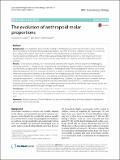| dc.contributor.author | Carter, Katherine E. | en_US |
| dc.contributor.author | Worthington, Steven | en_US |
| dc.date.accessioned | 2016-06-14T18:53:22Z | |
| dc.date.issued | 2016 | en_US |
| dc.identifier.citation | Carter, Katherine E., and Steven Worthington. 2016. “The evolution of anthropoid molar proportions.” BMC Evolutionary Biology 16 (1): 110. doi:10.1186/s12862-016-0673-5. http://dx.doi.org/10.1186/s12862-016-0673-5. | en |
| dc.identifier.issn | 1471-2148 | en |
| dc.identifier.uri | http://nrs.harvard.edu/urn-3:HUL.InstRepos:27320422 | |
| dc.description.abstract | Background: Developmental processes that underpin morphological variation have become a focus of interest when attempting to interpret macroevolutionary patterns. Recently, the Dental Inhibitory Cascade (dic) model has been suggested to explain much of the variation in mammalian molar size proportions. We tested the macroevolutionary implications of this model using anthropoid primate species (n=100), focusing on overall morphological patterns, as well as predictions made about molar size variability, direct developmental control, and diet. Results: Of the species sampled, 56 % had centroids that fell within regions of molar proportion morphospace consistent with the dic model. We also found that the third molar had greater variation in size than either the first or second molars, as expected by the model. Some dic model predictions were not supported, however, such as the expected proportion of M2/M1 when the third molar is absent. Furthermore, we found that some variability in third molar size could not be explained by the influence of the inhibitory cascade. Overall, we found considerable clade-specific differences in relative molar sizes among anthropoid primates, with hominoids and cercopithecins strongly divergent from dic model predictions, and platyrrhines, colobines, and papionins more consistent with the inhibitory cascade. Finally, we investigated reasons why some clades deviated from dic model expectations. Adaptations for frugivory (e.g., bunodont cusp relief) appeared to be one driver of relatively larger second molars and have evolved independently in multiple lineages of anthropoids. Conclusions: The dic model explains some of the variation in anthropoid primate molar proportions. However, there are interesting deviations away from this broad mammalian pattern, particularly in hominoids and cercopithecins, which suggest the model is only one of multiple mechanisms determining morphological variability in mammalian teeth. Electronic supplementary material The online version of this article (doi:10.1186/s12862-016-0673-5) contains supplementary material, which is available to authorized users. | en |
| dc.language.iso | en_US | en |
| dc.publisher | BioMed Central | en |
| dc.relation.isversionof | doi:10.1186/s12862-016-0673-5 | en |
| dc.relation.hasversion | http://www.ncbi.nlm.nih.gov/pmc/articles/PMC4875740/pdf/ | en |
| dash.license | LAA | en_US |
| dc.subject | Molar proportions | en |
| dc.subject | Dental inhibitory cascade | en |
| dc.subject | Anthropoid primates | en |
| dc.subject | Evo-devo | en |
| dc.subject | Bayesian phylogenetic generalized linear mixed models | en |
| dc.title | The evolution of anthropoid molar proportions | en |
| dc.type | Journal Article | en_US |
| dc.description.version | Version of Record | en |
| dc.relation.journal | BMC Evolutionary Biology | en |
| dash.depositing.author | Carter, Katherine E. | en_US |
| dc.date.available | 2016-06-14T18:53:22Z | |
| dc.identifier.doi | 10.1186/s12862-016-0673-5 | * |
| dash.contributor.affiliated | Carter, Katherine E. | |
| dash.contributor.affiliated | Worthington, Steven | |


